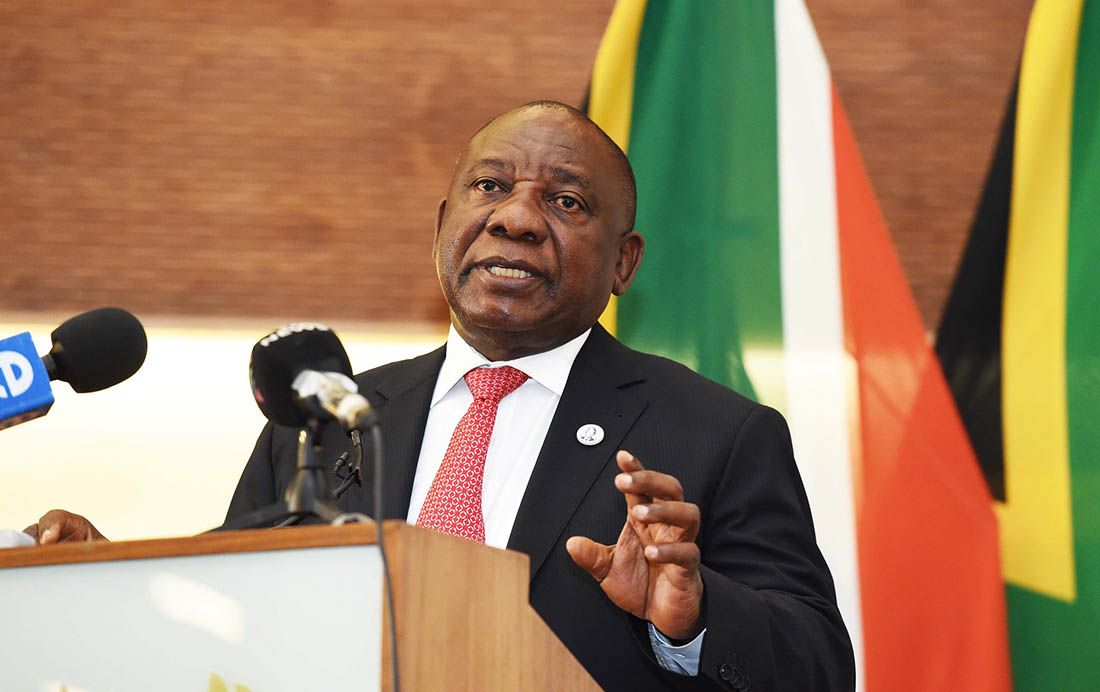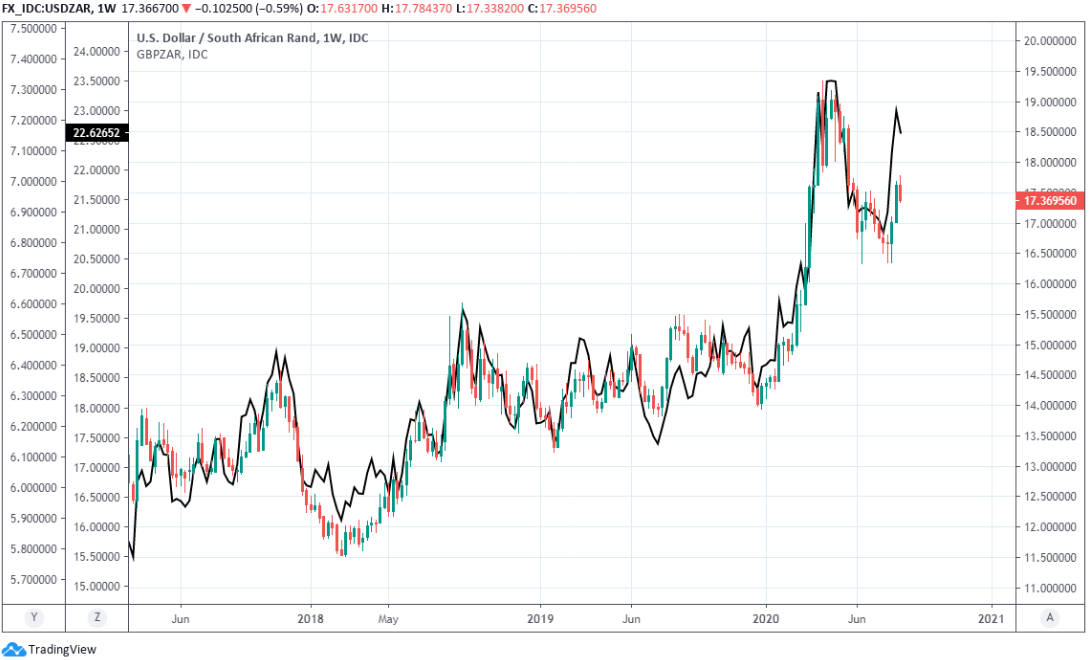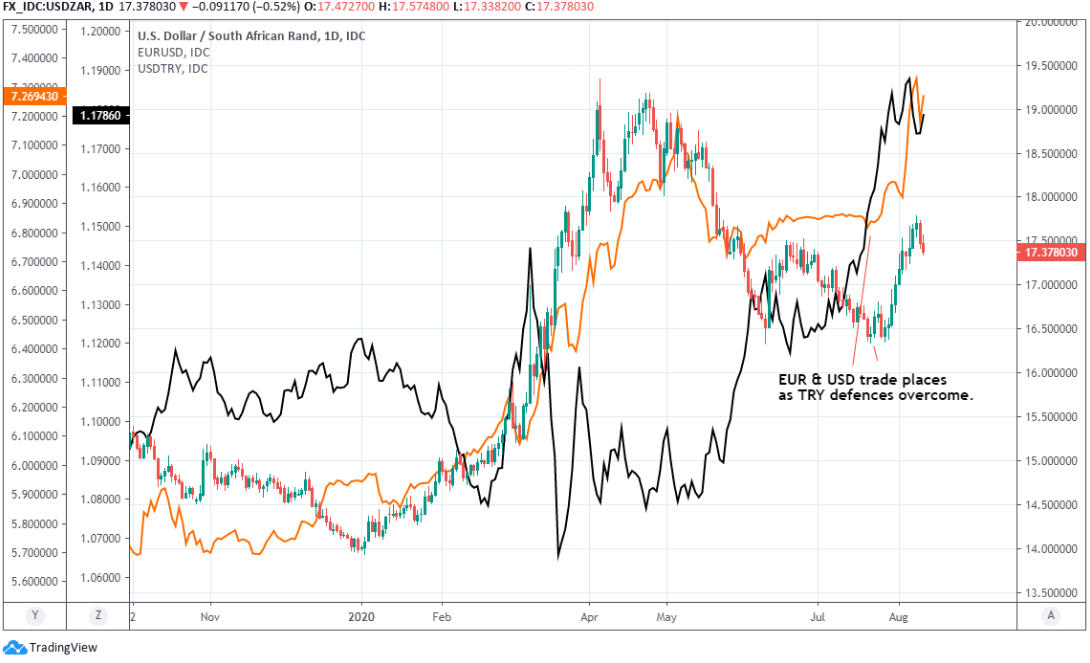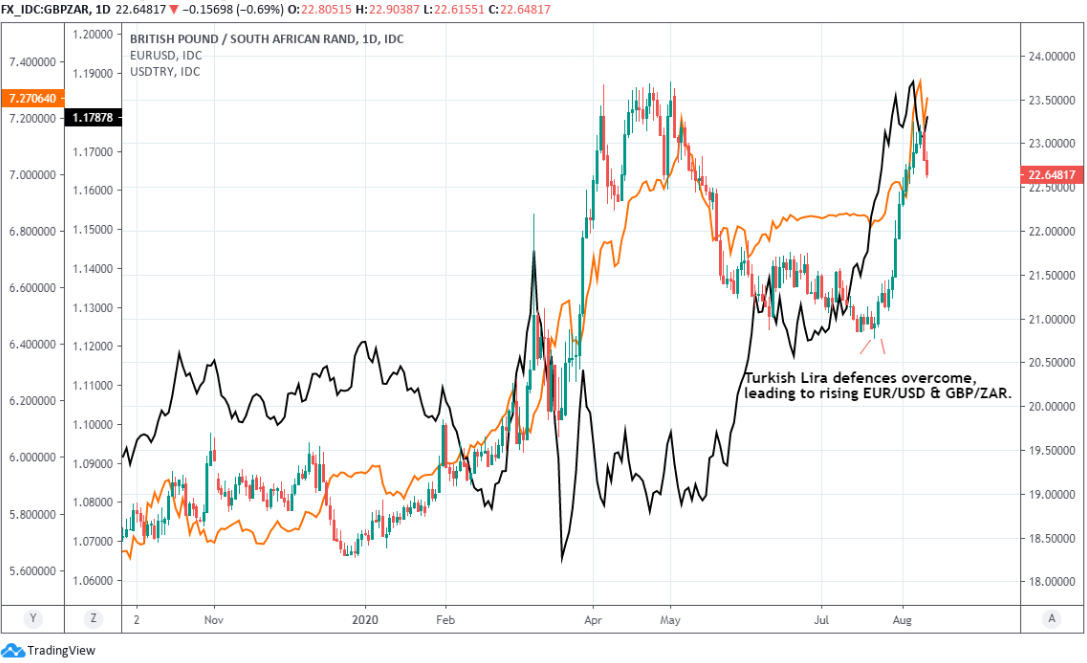South African Rand Lifts from 10-Week Low but Lira Troubles Threaten to Stoke Volatility
- Written by: James Skinner

Image © Adobe Images & Government of South Africa.
- GBP/ZAR spot rate at time of writing: 22.69
- Bank transfer rate (indicative guide): 21.90-22.06
- FX specialist providers (indicative guide): 22.35-22.49
- More information on FX specialist rates here
The Rand outperformed all major developed and emerging market rivals on Wednesday amid speculation suggesting South Africa's lockdown could be further eased in the coming days, although an ongoing depreciation of the Turkish Lira risks stoking volatility in the weeks ahead.
South Africa's Rand led a global advance on the Dollar Wednesday as the U.S. currency sank against all most other than safe-haven counterparts and an increasingly under-the-cosh Turkish Lira.
The Lira suffered as the EUR/TRY rate rose more than 1.5% owing to strong simultaneous increases in USD/TRY and EUR/USD.
Rand gains extended Tuesday's recovery off 10-week lows that were struck at the height of the Turkish Lira's depreciation on Monday, but came amid reports that President Cyril Ramaphosa could announce a relaxation of the country's 'lockdown' by the weekend, offering relief to the badly bruised economy.
"With the rand, and market sentiment, likely remaining volatile for the rest of this year, the domestic currency will continue to follow an uneven path, but the trend is expected to be, overall, of some further strength, as the expected case remains one of recovery to some extent in the global economy," says Annebel Bishop, chief economist at Investec. "We continue to expect that the domestic currency will average R17.00/USD this quarter, and R16.50/USD next."
Above: USD/ZAR rate at daily intervals alongside EUR/USD (black line, left axis) and USD/TRY (orange line, left axis).
Rand gains came shortly as the EUR/USD and USD/TRY rates recovered from Monday losses although USD/ZAR has followed both higher thus far in August and expectations are for further pressure on the Lira amid specilation that Turkey's central bank may have exhausted its ability to prop up the currency.
"With inflation (at about 12%) far above the central bank’s 8.25% policy rate, the real interest rate in Turkey is once again deeply negative – far more so than in any other major economy. That creates downward pressure on the lira, since the nominal exchange rate needs to depreciate in order to avoid an appreciating real exchange rate," says Jonas Goltermann at Capital Economics. "Perhaps most importantly, the central bank’s independence is limited. Its reluctance to raise policy rates appears to ultimately stem from President Erdogan’s unwillingness to countenance higher interest rates that would hurt economic growth in the near term. While the central bank has tightened monetary conditions this week by withdrawing some liquidity facilities, which has raised domestic interbank rates and helped the lira stabilise for now, we think that, as in 2018, policymakers are more likely to turn to import tariffs and partial capital controls next, and would only hike policy rates as a last resort."
Escalated depreciation of the Lira had been steadily sinking other emerging market boats like the Rand since late July although it was a rising Euro-to-Dollar rate that did much of the heavy lifting involved in pushing the Turkish currency to new lows, which is somewhat ironic because conventional wisdom has it that the single currency's ongoing gains are the result of an EU recovery fund that has improved the continent economic outlook and enhanced risk appetites.
Sharp gains for EUR/TRY have been driven in a sometimes alternating fashion by increases in USD/TRY and EUR/USD amid what is seemingly a campaign by the market to push Turkish interest rate policy in a different direction. This is almost as significant for the Rand outlook as it is the Turkish Lira given the South African currency is normally averse to a rising Dollar, which is almost always the result of meaningful falls in the Euro-to-Dollar rate.
Above: Pound-to-Rand rate at daily intervals with EUR/USD (black line, left axis) and USD/TRY (orange line, left axis).
To the extent that August's gains in the Euro-to-Dollar rate has been driven by flows seeking to influence Turkish monetary policy, the Rand could be at risk in the event of a capitulation from the country's central bank because such an outcome might then be enough to prompt a correction in the Euro-to-Dollar rate.
A direct intervention in the currency market by Turkish authorities might also be felt through Euro-to-Dollar rate losses given that declines in this exchange rate are a more efficient and effective route to a lower EUR/TRY, which is effectively an amalgamation of EUR/USD and TRY/USD.
A falling Euro-to-Dollar rate means upward pressure on the Dollar and downward pressure on prices of key commodities. A stronger U.S. currency can also raise the cost of servicing emerging market debt and lift new funding costs.
As a result, a falling EUR/USD rate might still produce a rising USD/ZAR even if the two have followed each other thus far in August.
"A setback followed at the beginning of August as risk aversion picked up again. We assume that the rand will remain vulnerable and that it will only be able to benefit to a limited extent in the medium term from the continued weakness of the USD," says Elisabeth Andreae, an analyst at Commerzbank. "Risks to ZAR include not only an unfavourable course of the pandemic with further (major) waves of infection, but also renewed fears of an emerging market crisis or an escalation in US-Chinese (trade) relations."

Above: USD/ZAR and Pound-to-Rand (black line, left axis) rates at daily intervals.






